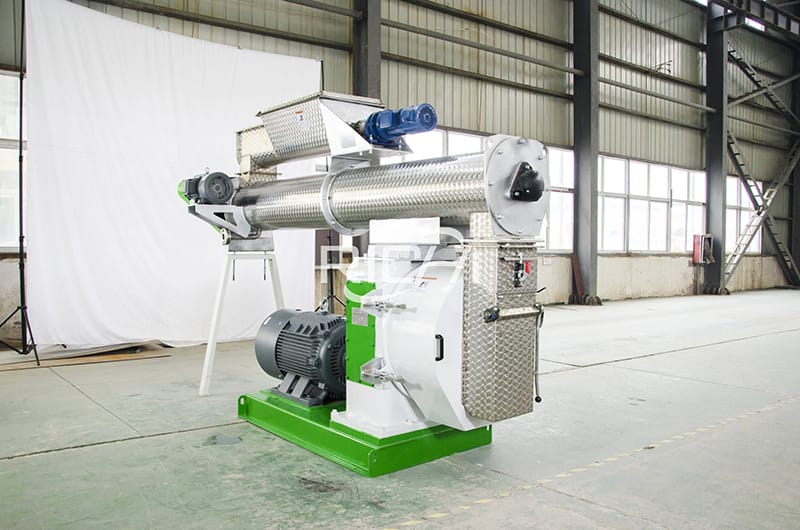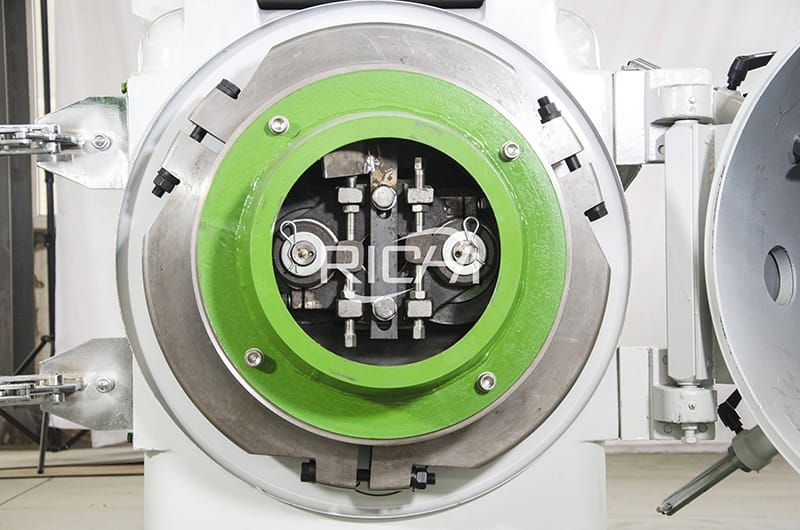Material residues and cross-contamination prevention and control measures in feed line production and transportation
The problem of material residues in feed production and transportation is an important cause of cross-contamination of feed products in animal feed making plant. Due to the existence of material residues, a batch of feed products mixed with previous product substances that should not have appeared, including drugs or harmful microorganisms, will cause cross-contamination and affect the stability of the final feed product quality. In order to ensure the stability of feed quality and safety, it is necessary to systematically study the causes of material residues in feed processing and transportation, and take effective operational procedures to prevent and control material residues and reduce the risk of cross-contamination.

1.Analysis of equipment residue sources
In the current feed industry, there are many complete sets of equipment used to store, process, and transport feed products until they are fed to animals. All of these complete sets of equipment are composed of basic components such as feed storage equipment, feed conveying equipment and feeders, and these equipment may produce material residues. For example, animal feed mixer machine, ring die animal feed pelletizers, screw conveyors, bucket elevators, dust collectors, batching bins, etc. may contain dust and material residues, which may cause pollution to the next batch of feed production.
This process may occur in a single device, or in a combined area of the entire system. For example, in the storage system, the most common feed storage equipment is a vertical silo, most of which are made of metal materials, but also include wood, concrete and other materials. The normal material flow pattern of the silo is that the material directly above the discharge port will fall first, and then the material in the silo will be discharged in a cascade form from top to bottom in a "V" shape. The result is that the material flows step by step from top to bottom until it is discharged.
However, if the slope of the hopper at the bottom of the silo is designed unreasonably, or the amount of molasses and grease in the material is high, some materials can resist the lateral flow and form a material tunnel. People call it a "rat hole", which leads to Large quantities of material residues are produced. In screw conveying equipment, mixers and conditioners, there is generally a proper clearance space between the screw or blade and the machine wall. This gap is necessary to prevent excessive wear between the outer edge of the blade and the machine wall, but at the same time When there is no more material at the discharge port, there is still a layer of material remaining in the machine.
The electrostatic adsorption effect will cause small particles to adhere to the inner wall of the mixer or other equipment. Some drug premix particles are easier to be adsorbed due to their electrostatic characteristics. After the production of medicated feed, sufficient drugs will directly affect the subsequent batches. For feed production, grounding mixing and conveying equipment will minimize this residue, and larger particle size drug premixes will reduce the possibility of electrostatic adsorption residues. Below we have summarized some of the main causes of material residues in feed line processing and transportation equipment.
(1) Dust removal system
Delayed return; excessive vacuuming of drugs and delivery equipment; adsorption (static or wet).
(2) Mixing equipment
Feed residue; material accumulation on the spiral ribbon or inner wall; electrostatic adsorption; leakage of the discharge gate.
(3) Buffer warehouse
Incomplete cleaning; adsorption (static or damp).
(4) Conveying equipment
Incomplete cleaning; adsorption (static or damp).
(5) Hoist
Dump and base material remains; adsorption (static or damp).
(6) Ingredients warehouse
Arching; incomplete cleaning.
(7) Bulk truck
Wrong discharge records; incomplete cleanup.

2.Equipment residue removal measures
Once the cause of the equipment material residue is determined, the correct countermeasures can be implemented. Usually, equipment adjustments can significantly reduce problems, including repairs, redesigns, or replacement of damaged parts, etc. are all necessary.
3.Optimizing equipment process combination
While doing a good job in the removal of single equipment residues, we must also pay attention to the process combination between processing equipment to further reduce possible cross-contamination.
(1)One is in the design of the animal feed pellet producing line. Specialized animal feed producing lines should be used to produce specific types of animal feed, such as pig feed production line, suckling pig feed production processing line, layer chicken feed production plant, broiler feed production line, fish feed production line, shrimp feed processing line, etc. Among them, the ruminant cattle feed production line should be set up independently.
(2)The second is the layout of transmission lines. Short-circuit transmission should be used as much as possible to reduce material classification and cross-contamination.
(3)The third is that the mixed medicated powder feed should be pelletized directly.
(4)The fourth is to set up a special storage bin for washing and returning materials in the process design to realize the mechanization and automation of the recycling of these materials.
4. Do a good job in production sequencing and flushing
When producing pre-slaughter animal feed containing drugs during the drug withdrawal period or simultaneously producing and transporting multiple animal feeds, it must be produced in strict accordance with the label and comply with the feed production safety management regulations of the feed factory to avoid drug cross-contamination. The safety management regulations stipulate reasonable operating procedures for all the equipment used in the production and delivery of medicated feed to avoid unsafe pollution between medicated and non-medicated feed. The following is our summary of measures to deal with feed residues.
(1) Electrostatic adsorption
Measures: ground the equipment; use non-static premix liquid raw materials to control dust; add a vibrator.
(2) Delayed return
Measures:Adjust the suction speed; allow enough time for cleaning; liquid raw materials to reduce dust; dispose of medicated feed dust (or add subsequent similar drug batches); optimize the design of the dust removal system.
(3) Animal feed mixing machine residue
Measures:Adjust the paddle or ribbon; install the ribbon sweeper; add an air sweeping device; redesign the discharge door to make the discharge safer; add medicine when the material reaches 1/2-3/4 of the mixer capacity; install manual The access door is convenient for manual cleaning and maintenance.
(4) Buffer warehouse and conveying equipment residue
Measures:Add more cleaning procedures; redesign the silo or discharge port.
(5) Hoist residue
Measures:Adjust the design of the base, the gap between the outer wall of the bucket and the arc bottom of the base is adjustable; add a base cleaning door or air cleaning device for thorough cleaning.
(6) Silo residue
Measures:Manual inspection and cleaning when changing the feeding type; add an air cleaner.
(7) Residues of animal feed pellet making machine and feed dryer
Measures:Flush the equipment; adjust the dryer for thorough cleaning.
(8) Conditioner residue
Measures:Increase the access door (the length is not less than 70% of the total length of the quenching and tempering chamber); increase the heating device on the outer shell, which is convenient for clearing the adhered materials on the inner wall.
(9) Bulk truck
Measures:Determine truck cleaning procedures and add purge devices; take samples during transportation; analyze samples randomly and inform the driver.
(1) Do a good job in sequencing production.
The need for sequencing in animal feed mill processing and transportation depends on the tendency for drug residues to occur. It is very effective to arrange the production of feeds containing the same medicine together and arrange them in order of drug content from high to low. The order should be after the production of non-medicated feed for the same animal. For example, when the tasks for the production of products on the day are sorted, the production sorting table should be made according to the principle of "drug-free first, drug-containing second". When producing feed products of the same animal with the same drug but different dosages, the production sequence is as follows: drug-free feed→low drug content feed→high drug content feed→washing (cleaning).
When individual feed mills need to produce a single breed of feed, such as pig feed, if the piglet feed needs to add drugs containing withdrawal period, the production sequence can be as follows: pig feed containing withdrawal period, sow feed, growing pig feed, finished pig feed. According to this order, the sows should be placed in the finished pig house and fed for a period of time before they are culled into the market. When using the sequential production mode to avoid drug cross-contamination, it is very necessary to make production records and to be able to determine in detail the production information of the previous batch of feed. However, the next batch of replacement production will break this production sequence. In most feed factories, good production sequencing can sufficiently reduce drug residues and eliminate the risk of tissue residues. However, when there are maintenance or design problems as shown above, sequencing production cannot reduce the residues to a very high level. Effective range.
(2) Strict flushing operation.
Washing feed processing equipment regularly is the easiest way to reduce cross-contamination and minimize the risk of feed cross-contamination. Washing is after the production of the previous batch of medicated feed and before the production of the next batch of feed, a certain amount of a certain solid material is used to pass through the animal feed pellet producing line to reduce the drug residue in the animal feed processing line. The United States and Canada use washing as a basic and necessary measure to control cross-contamination in the production of medicated animal feed.
Among the commonly used washing materials, organic materials such as soybean meal, corn flour, secondary flour, and bran are mainly used. For organic materials, such as corn flour, flour, etc., the washing effect of drug residues in feed machinery and equipment is better. Due to the high cellulose content in rice bran, the material is not uniform, the absorption effect of drugs is poor, and its washing effect is not as good as corn flour and flour.
Because stone powder is a mineral raw material, it has good fluidity and is easy to mix in the equipment within the same time. However, because the surface of the powder particles is smoother than other organic materials, it has weak adsorption capacity for drug residues in the machine. The scope of the washing production line is generally from the batching scale to the finished product packing mouth. The amount of flushing material added depends on the system. In the case of no prior verification, the recommended amount of flushing material is 80%-100% of the rated mixing capacity of the feed mixer machine.
When the flushing material passes through the feed processing and conveying system, it should be It is stored separately for use in the next production of the same medicated feed. The name and number of the washing material formed after the washing should be clearly identified and stored in categories, and a complete washing operation table should be formed with the product name and quantity of each batch of washing material to be reused, which should be confirmed before the start of the batching operation the animal feed production line has been flushed and meets the animal feed production requirements.
If you want to built one complete pellet production line in your country, pls send the inquiry to us. We will customized design according to your requirement.



